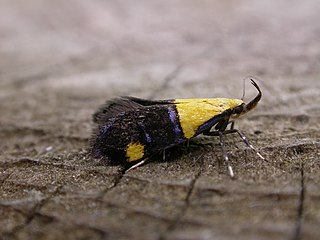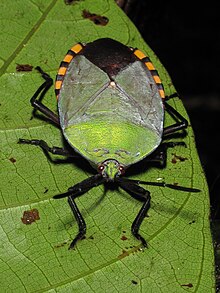
Genus is a taxonomic rank used in the biological classification of living and fossil organisms as well as viruses. In the hierarchy of biological classification, genus comes above species and below family. In binomial nomenclature, the genus name forms the first part of the binomial species name for each species within the genus.

In taxonomy, binomial nomenclature, also called binary nomenclature, is a formal system of naming species of living things by giving each a name composed of two parts, both of which use Latin grammatical forms, although they can be based on words from other languages. Such a name is called a binomial name, a binomen, binominal name, or a scientific name; more informally it is also historically called a Latin name. In the ICZN, the system is also called binominal nomenclature, "binomi'N'al" with an "N" before the "al", which is not a typographic error, meaning "two-name naming system".

The International Code of Zoological Nomenclature (ICZN) is a widely accepted convention in zoology that rules the formal scientific naming of organisms treated as animals. It is also informally known as the ICZN Code, for its publisher, the International Commission on Zoological Nomenclature. The rules principally regulate:

In zoological nomenclature, a type species is the species name with which the name of a genus or subgenus is considered to be permanently taxonomically associated, i.e., the species that contains the biological type specimen. A similar concept is used for suprageneric groups and called a type genus.
In zoological nomenclature, author citation is the process in which a person is credited with the creation of the scientific name of a previously unnamed taxon. When citing the author of the scientific name, one must fulfill the formal requirements listed under the International Code of Zoological Nomenclature. According to Article 51.1 of the Code, "The name of the author does not form part of the name of a taxon and its citation is optional, although customary and often advisable." However, recommendation 51A suggests, "The original author and date of a name should be cited at least once in each work dealing with the taxon denoted by that name. This is especially important and has a unique character between homonyms and in identifying species-group names which are not in their native combinations." For the sake of information retrieval, the author citation and year appended to the scientific name, e.g. genus-species-author-year, genus-author-year, family-author-year, etc., is often considered a "de-facto" unique identifier, although this usage may often be imperfect.
In zoological nomenclature, the valid name of a taxon is the correct scientific name for that taxon. The valid name must be used for that taxon, regardless of any other name that may currently be used for that taxon, or may previously have been used. A name can only be valid when it is an available name under the International Code of Zoological Nomenclature (ICZN); if a name is unavailable, then it cannot be considered either valid or invalid.
In biology, a homonym is a name for a taxon that is identical in spelling to another such name, that belongs to a different taxon.

Montifringilla is a genus of passerine birds in the sparrow family Passeridae. It is one of three genera containing the snowfinches. As the English and scientific names suggest, these are high-altitude species, found in the mountain ranges of southern Eurasia, from the Pyrenees east to the Himalayas, Tibet and western China.

Anthia is a genus of the ground beetle family (Carabidae) from Africa and Asia. Species of Anthia can spray a jet of formic acid up to 30 centimetres (12 in), which, if not treated, can cause blindness in animals that harass the beetles.

A conserved name or nomen conservandum is a scientific name that has specific nomenclatural protection. That is, the name is retained, even though it violates one or more rules which would otherwise prevent it from being legitimate. Nomen conservandum is a Latin term, meaning "a name to be conserved". The terms are often used interchangeably, such as by the International Code of Nomenclature for Algae, Fungi, and Plants (ICN), while the International Code of Zoological Nomenclature favours the term "conserved name".
In zoological nomenclature, a nomen oblitum is a disused scientific name which has been declared to be obsolete in favour of another "protected" name.
The Botanical and Zoological Codes of nomenclature treat the concept of synonymy differently.

Priority is a fundamental principle of modern botanical nomenclature and zoological nomenclature. Essentially, it is the principle of recognising the first valid application of a name to a plant or animal. There are two aspects to this:
- The first formal scientific name published for a plant or animal taxon shall be the name that is to be used, called the valid name in zoology and correct name in botany.
- Once a name has been used, no subsequent publication of that name for another taxon shall be valid (zoology) or validly published (botany).
Fusus is a genus of small to large sea snails, marine gastropod molluscs in the family Fasciolariidae, the spindle snails and tulip snails.

Oecophora is a genus of the concealer moth family (Oecophoridae). Among these, it belongs to subfamily Oecophorinae. It is the type genus of its subfamily and family. Thus, regardless of the uncertain phylogeny, systematics and taxonomy of its superfamily Gelechioidea, it and its closest relatives always have to be assigned to this family and subfamily as long as these are deemed valid.

This is a list of terms and symbols used in scientific names for organisms, and in describing the names. For proper parts of the names themselves, see List of Latin and Greek words commonly used in systematic names. Note that many of the abbreviations are used with or without a stop.

Chydarteres striatus is a species of beetle in the family Cerambycidae. It was described by Johan Christian Fabricius in 1787, and while his name was preoccupied, it is treated as valid following ICZN Article 23.9.5.

Stromatium fulvum is a species of beetle in the family Cerambycidae. It was first described by Charles Joseph Devillers in 1789, and while his name was preoccupied, it is treated as valid following ICZN Article 23.9.5; it has most commonly been referred to as Stromatium unicolor, and more recently as Stromatium auratum but these names are junior synonyms.
Mimonephelotes enganensis is a species of beetle in the family Cerambycidae, and the only species in the genus Mimonephelotes. It was described by Breuning in 1970. Breuning mistakenly thought the name was a junior homonym of the genus Mimonephelotus and proposed a replacement name, Mimanhammus in 1971, but under the ICZN the two names are not homonyms, so the original genus name is valid.

Pycanum is a genus of bugs in the family Tessaratomidae.













